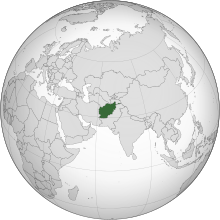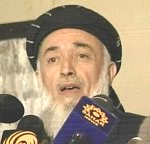List of heads of state of Afghanistan
The list of heads of state of Afghanistan contains the rulers of the modern state of Afghanistan , whose history begins in 1747 at the earliest.
Rulers and dynasties that ruled the area of present-day Afghanistan or parts of it before this date, ie mainly during the Middle Ages , can be found in the list of rulers of Iran or the list of Islamic dynasties .
Durrani monarchs
Since the disintegration of the great empire established by Nadir Shah (r. 1736–1747) gradually began to emerge as a state structure increasingly referred to as Afghanistan , this country between India and Persia was ruled by rulers who belonged to the Pashtun Abdali or Durrani tribal confederation . However, a distinction must be made between two successive dynasties, each representing one of the 10 tribes of this confederation.
Popalzi / Sadozi kings (1747–1843)
The temporary and northern India and was founded in Khorasan comprehensive Durrani Empire the nucleus of modern Afghanistan - - 1747 by a military leader Nadir Shah, of the Abdali tribe of Popalzi belonged, specifically for Popalzi- communities of Sadozi . He took the title Durr-i Durran ("Pearl of Pearls"), from which the name Durrani is derived. His descendants ruled the country until another Durrani tribe finally seized power in 1843 and toppled the Popalzi / Sadozi dynasty.
- Ahmad Shah (ruled 1747–1773 in Kabul and Kandahar )
- Timur Shah (ruled 1773–1793 in Herat , from 1775 also in Kabul)
- Zaman Shah (ruled 1793–1801 in Kabul and Kandahar, from 1797 also in Herat)
- Mahmud Shah (ruled 1800–1803 and 1809–1818 in Kabul and Kandahar, until 1829 in Herat)
- Qaysar (ruled 1803 in Kabul and Kandahar, 1807–1808 in Kashmir )
- Shah Shuja (ruled 1803–1809 and again with British help 1839–1842 in Kabul and Kandahar)
- Kamran (r. 1818–1842 in Herat)
- Ali Shah (ruled 1818–1819 as a Barakzai puppet in Kabul)
- Ayyub Shah (ruled 1819–1823 as a Barakzai puppet in Kabul)
- Habibullah (ruled 1823–1826 as a Barakzai puppet in Kabul)
- Fath Dschang (r. 1842–1843 in Kabul)
Barakzi / Mohammadzi emirs / kings (1826–1973)
From 1818 to 1839 Kabul was de facto ruled by a man who did not belong to the Popalzi tribe like the puppet kings he had appointed until 1826, but to the Mohammedzi clan within the Abdali / Durrani tribe of the Barakzi . Since 1834 Emir he took over in 1843, after a brief restoration of Sadozi power, eventually final rule in the kingdom and founded a new dynasty, Afghanistan to a brief interregnum reigned in 1929th After that, power remained with the Barakzi clan of the Mohammedzi, but rule was passed to another branch of the family (the "Mosaheban" from Peshawar ). In 1973 the last Durrani monarch had to abdicate and the Kingdom of Afghanistan became a republic .
Kabul branch
- Dost Mohammad (ruled from 1843 until June 9, 1863 in Kabul (where he had ruled from 1818 / 26–1839), in Kandahar from 1855, in Herat from 1863)
- Shir Ali (ruled June 1863 to 1866 and 1868 to February 21, 1879 in Kabul)
- Mohammed Afzal (reigned 1866–1867 in Kabul)
- Mohammed Azam (r. 1867–1868 in Kabul)
- Mohammed Yakub (ruled from 1878 for his father Scher Ali and from February 1879 to October 1879 alone in Kabul)
( British occupation of eastern Afghanistan 1879–1880 )
- Musa (ruled interim 1879–1880)
- Mohammed Ayub (ruled interim 1880)
- Abdurrahman (ruled July 22, 1880 to October 1, 1901)
- Habibullah (I.) (ruled October 1, 1901 to February 20, 1919)
- Amanullah (ruled February 20, 1919 to January 14, 1929; from 1926 as king)
- Inayatullah (ruled January 14, 1929 to January 17, 1929)
- Habibullah (II.) (Ruled January 17, 1929 to October 13, 1929; did not belong to the dynasty)
Peshawar branch
- Mohammed Nadir (ruled October 17, 1929 to January 8, 1933)
- Mohammed Zahir (ruled January 8, 1933 to July 17, 1973)
Presidents of the Republic of Afghanistan (1973–1978) and the Democratic Republic of Afghanistan (1978–1992)
When the last Barakzi / Mohammedzi king was abroad, his cousin and former prime minister took the opportunity and proclaimed the first Afghan republic , of which he became president. However, a military coup took place as early as 1978, which resulted in ongoing unrest and the establishment of the communist Democratic Republic of Afghanistan . This went down in a civil war when, after the withdrawal of the Soviet Union, which intervened in the country from 1979 to 1989 (see Soviet-Afghan War ), Islamic resistance fighters, mujahedin , took power.
Republic of Afghanistan
- Mohammed Dawud (ruled July 17, 1973 to April 27, 1978)
Democratic Republic of Afghanistan
- Mohammed Taraki only (ruled April 27, 1978 to October 8, 1979)
- Hafizullah Amin (ruled October 8, 1979 to December 27, 1979)
- Babrak Karmal (ruled December 27, 1979 to November 21, 1986)
- Hajji Mohammed Tschamkani (ruled November 23, 1986 to September 29, 1987)
- Mohammed Najibullah (ruled September 29, 1987 to April 15, 1992)
- Abdurrahim Hatef (ruled April 19, 1992 to April 28, 1992)
Mujahideen (1992–1996) and Taliban government (1996–2001)
The fall of the last president of the republic was followed in 1992 by the establishment of an “Islamic state” under the mujahideen presidents. Then the deobandic - Islamist Taliban seized power and founded the Islamic Emirate of Afghanistan .
Mujahideen
- Sibghatullah Modschaddedi (ruled April 28, 1992 to June 28, 1992)
- Burhanuddin Rabbani (ruled June 28, 1992 to September 27, 1996, de jure until 2001)
Taliban
- Mohammed Omar (ruled September 27, 1996 to November 11, 2001)
President of the Islamic Republic of Afghanistan (since 2001)
The Islamic Republic of Afghanistan has existed since the fall of the Taliban regime by troops of the Afghan United Front in cooperation with American and British special forces during the US-led intervention in Afghanistan .
- Burhanuddin Rabbani (ruled November 17, 2001 to December 22, 2001)
- Hamid Karzai (ruled December 22, 2001 to 2014)
- Ashraf Ghani Ahmadsai (ruled since 2014)
literature
- Peter Truhart (Ed.): Regents of Nations. Systematic Chronology of States and their political Representatives in Past and Present. A biographical reference book. = Rulers of the nations. Volume 3: Asia & Pacific Oceania. 2nd, revised and expanded edition. KG Saur Verlag, Munich 2003, ISBN 3-598-21545-2 .




